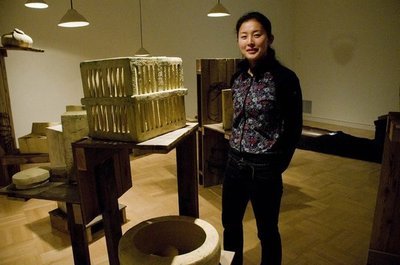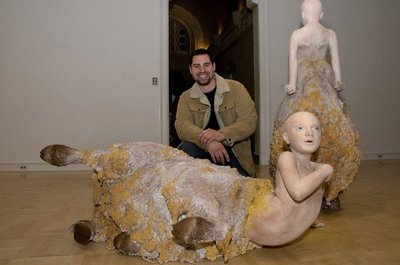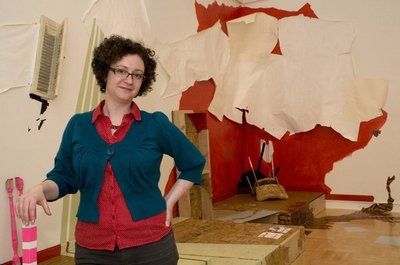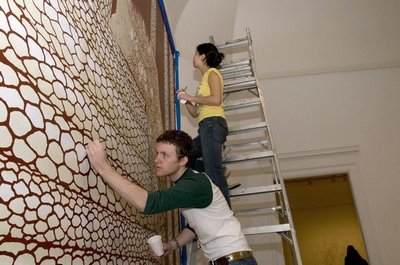May 22, 2008
Making meaning: Master of Fine Arts students show their work at the Henry
Straws. Dirt. Plaster. Mattress springs. An overturned chair. Small rectangles of wood. Just things, really — meaningless on their own. But artists can breathe meaning into the mundane.
At Master of Fine Arts 2008, this year’s exhibit of UW School of Art graduate students at the Henry Art Gallery, such everyday items are used in art to inspire, entertain and even provoke. The exhibit, showing the work of about 20 artists, will run through June 15 in the Henry’s North Gallery.
Most times, art must speak for itself, the artist having moved on to other challenges. The pleasure of a press preview, such as was held last Thursday, is that the artists get a chance to explain the thinking behind their work. The MFA students, many of whom will become teachers of art, were eager to discuss their work.
Visitors aren’t likely to miss Noah Grussgott’s sculpture Primary Institution, a towering, playgroundlike structure of recognizable parts whose impervious steel and darkened portholes offer a mixed message — it attracts but also “negates the ability to play,” the artist said. Children beware.
A couple of rooms away, Julie Alpert’s mixed media installation grabs the eye with a bloodlike splash of red commanding one corner of what looks like a room that has exploded into chaos. The piece is titled Questioning the Fabric of Reality Using Formal Considerations of Painting and Drawing. Alpert said, “I wanted to create a process-based piece. The piece is based on the making of it — none of this existed before I got to the Henry.”
An upturned chair adorns with a painted black shadow that makes you look twice. The room tells a story, Alpert said, but not the same one to every viewer. “It’s sort of like reading a novel. You can piece things together and make up a story in your head.” (She confessed that all the red makes her think of Stephen King’s The Shining, saying, “For some reason, that red keeps showing up in my work.”)
Childlike figures seem to meld with mineral in Jason Loik’s sculpture Usurping Youth’s Authority. Alicia Basinger’s Tracing Time combines hydrocal, acrylic and plywood for a solemn, textured piece that looks almost waxlike. Interact with Molly Epstein’s Device #1: Heart and it will detect your heartbeat. A reflecting pool is installed in a mound of dirt to create shimmering imagery in Allison Quemere’s Three Second Memory.
Along one wall, artist Ryan Finnerty gets some help finishing up a 300-square-foot mural featuring a stand of Loblolly Pines, standing and stacked. Its name, more than 40 words long, befits its size but wasn’t yet posted: “I think they’re still typing it up,” he joked.
One room over, artist Rachel de Conde stands ready to explain her installation piece of wood and ceramic titled Endemic, Drift. Shapes of ceramic reach up like coral among hundreds of pieces of wood. “For me it was a fascination with things that don’t necessarily belong, or the idea of an endemic environment,” she said. “The wooden structures are the growing establishment for these ceramic pieces and they only grow together and they would only grow in a specific environment.” Though the work has been installed, it isn’t necessarily done. “I feel like I can always continue the work,” she said. “I make it, and then I can continue to grow off of it.”
There are labors of love here, too. Photographer Zack Bent stands proudly by vivid photographs featuring himself and family members interacting warmly, especially one young son. He credited his wife for the photos in which he appears and added that in time they might take a collaborative title: “Bent Family Productions.”
Some artists based their work on personal experiences and memories. Kinu Watanabe’s Belongings (beautifully lit, by the way, with the pieces sculpted in shadow and light) offers vintage-looking artifacts made from the memory of a century-old storehouse in Japan.
Susanne Lechler Osborn, who is from Germany, dug deeply into her national memory and conscience for Stain, a compelling piece where text cut from newspapers, some seemingly rusted with age, bloom in flowerlike patterns. “This is about my background. It’s a personal piece I felt compelled to make now. It reflects the 20th century events in Germany where people gave up their individual moral integrity — out of fear, perhaps.” In that light the piece seems more sorrowful — beauty complicated and marred by stark reminders of loss. “I wanted to make a meaningful piece about all the people who passed, who perished in that historical time. They don’t have a voice — they’re missing.”
Perhaps less personal are the 12,000 flexible drinking straws and 10,000 zip-ties that went into Evan Blackwell’s Crystallization of the Moment, where a crystal-like form composed of straws grows seemingly unstoppably from the wall. “If I had the whole gallery space this thing would stretch across the whole room,” he said. Asked if he plans to recreate the piece anywhere, Blackwell replied with a smile: “No, this might be the last straw.”
Social justice is at the heart of Nicki Sucec’s installation piece Home is the Most Important Place in the World. Part the curtain and step inside to see candles and hear recorded testimony from a recent hearing about homelessness in Seattle. Dog tag-like pieces hang from just beneath mattress springs above — imagery of home and comfort turned outward, taking note of those who have little and die alone.
Every year for this exhibit, School of Art faculty advisers consult with artists to work through their concepts for the show, and all the pieces are chosen by the students and their thesis committees, with assistance from Jim Rittimann, the Henry’s head preparator and exhibit designer — and an artist in his own right.
Rittimann said he helps the artists put their best foot forward and advises them if an idea looks like it won’t work for the gallery. “My task is to make it look good as a whole, from an exhibition designer’s point of view,” he said.
And though the artists are students, they benefit from having to consider the practicalities of installing their piece at the Henry or moving it there from the School of Art. They don’t all get everything they want, but that too is like the real world.
“What we try to do at the Henry is to give them a professional experience and steer them in the right direction. We treat them like professional artists,” Rittimann said.
And if the art in Master of Fine Arts 2008 is any indication, the students respond with that same professionalism.






